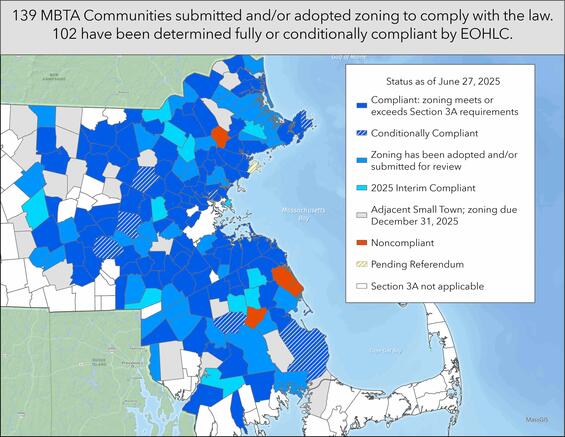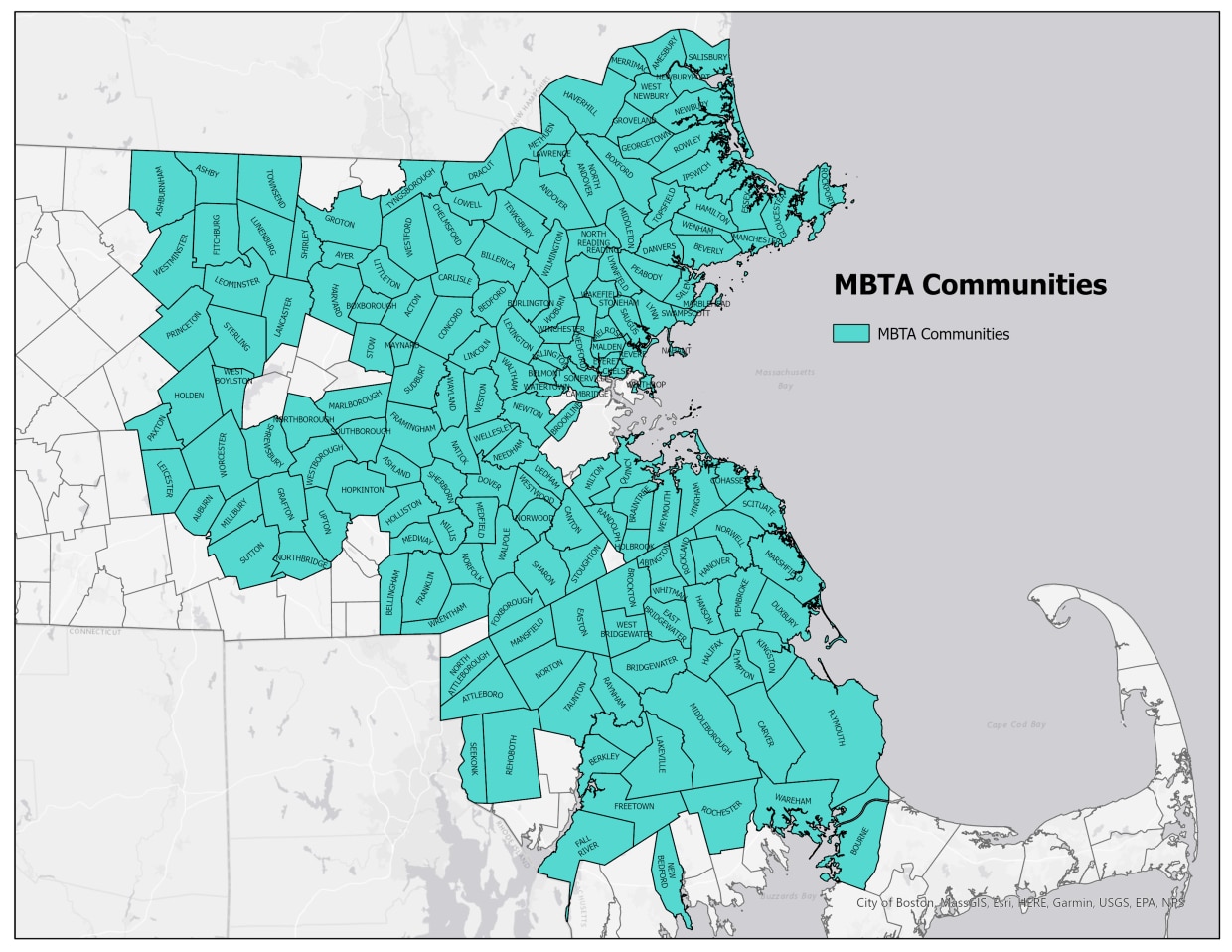What is an "MBTA Community"?
“MBTA community” is defined by reference to Section 1 of MGL c. 161A:
- one of the “14 cities and towns” that initially hosted MBTA service;
- one of the “51 cities and towns” that also host MBTA service but joined later;
- other “served communities” that abut a city or town that hosts MBTA service; or
- a municipality that has been added to the MBTA under G.L. c. 161A, sec. 6 or in accordance with any special law relative to the area constituting the authority.
In total, 177 MBTA communities are subject to the requirements of Section 3A of the Zoning Act. While served by the MBTA, Boston is exempted from the Zoning Act, including section 3A. This is illustrated in the map below.
Why is multi-family zoning near transit and in neighboring communities important?
Massachusetts is in a housing crisis.
- Massachusetts has among the highest, and fastest growing, home prices and rents of any state in the nation.
- Rising costs have dramatically increased financial pressures on low- and middle-income families, forcing them to sacrifice other priorities in order to pay housing costs. High housing costs are a primary driver of homelessness.
- These high costs are a disadvantage as we compete economically against peer states. The risk of future job growth moving outside Massachusetts is rising due to the high costs of living.
How does creating zoning for multi-family housing help the housing crisis?
The lack of zoning for multi-family housing is a barrier for new housing development in Massachusetts. By allowing multifamily housing near transit, we can create new housing in walkable neighborhoods closer to transit. This is not just good housing policy, it is good climate and transportation policy, too. The result of transit-oriented development is:
- More housing closer to the places that we go every day, such as local shops, jobs, schools, restaurants, parks, etc.
- Better access to work, services, and other destinations by increasing mobility and utilization of public transit
- Reduced reliance on single occupancy vehicles, which helps in our larger effort to confront the climate crisis, reduce our region's traffic congestion, and makes our roads safer and our air cleaner.
What is the law?
The requirement is codified as Section 3A of MGL c. 40A:
Section 3A. (a)(1)An MBTA community shall have a zoning ordinance or by-law that provides for at least 1 district of reasonable size in which multi-family housing is permitted as of right; provided, however, that such multi-family housing shall be without age restrictions and shall be suitable for families with children. For the purposes of this section, a district of reasonable size shall: (i) have a minimum gross density of 15 units per acre, subject to any further limitations imposed by section 40 of chapter 131 and title 5 of the state environmental code established pursuant to section 13 of chapter 21A; and (ii) be located not more than 0.5 miles from a commuter rail station, subway station, ferry terminal or bus station, if applicable.
(b) An MBTA community that fails to comply with this section shall not be eligible for funds from: (i) the Housing Choice Initiative as described by the governor in a message to the general court dated December 11, 2017; (ii) the Local Capital Projects Fund established in section 2EEEE of chapter 29; (iii) the MassWorks infrastructure program established in section 63 of chapter 23A, or (iv) the HousingWorks infrastructure program established in section 27½ of chapter 23B.
(c) The executive office of housing and livable communities, in consultation with the executive office of economic development, the Massachusetts Bay Transportation Authority and the Massachusetts Department of Transportation, shall promulgate guidelines to determine if an MBTA community is in compliance with this section.
Attorney General Advisory
On March 15, 2023, Massachusetts’ Attorney General Andrea Campbell issued an Advisory concerning the enforcement of the requirements imposed on cities and towns by Chapter 40A, Section 3A.
The law requires that an MBTA community shall have at least one zoning district of reasonable size in which multi-family housing is permitted as of right, and that meets other criteria set forth in the statute. Failure to comply with the law results in a loss of eligibility for the community, for certain funding programs.
The Attorney General’s Advisory states “All MBTA Communities must comply with the Law.” The Advisory further states that “MBTA Communities cannot avoid their obligations under the Law by foregoing this funding.”
In addition, the Advisory cautions that “Communities that fail to comply with the Law may be subject to civil enforcement action” and, “Communities that fail to comply with the Law’s requirements also risk liability under federal and state fair housing laws. The Law requires that MBTA Communities “shall have” a compliant zoning district and does not provide any mechanism by which a town or city may opt out of this requirement.”
The Attorney General’s press release and the text of the Advisory are available here:
Section 3A Requirements
MBTA Community Categories
All communities served by the MBTA must zone to allow for multifamily housing as of right, with a greater obligation for communities with better access to transit stations.
Section 3A Regulations
MBTA Community Categories and Requirements
* Minimum multi-family unit capacity for most communities will be based on the 2020 housing stock and the applicable percentage for that municipality's community type. In some cases, the minimum unit capacity is derived from an extrapolation of the required minimum land area multiplied by the statutory minimum gross density of 15 dwelling units per acre. In cases where the required unit capacity from these two methods would exceed 25% of the community's housing stock, the required unit capacity has instead been capped at that 25% level.
** Minimum land area is 50 acres for all communities in the rapid transit, commuter rail and adjacent community types. There is no minimum land area requirement for adjacent small towns. Where 50 acres exceeds 1.5% of the developable land area in a town, a cap has been instituted that sets minimum land area to 1.5% of developable land area in the town.
*** Developable station area is derived by taking the area of a half-mile circle around an MBTA commuter rail station, rapid transit station, or ferry terminal and removing any areas comprised of excluded land.
Additional Resources
Compliance Model
The compliance model is the primary tool for measuring a zoning district for compliance with Section 3A. There are several zoning requirements in Section 3A related to district size and location, multi-family unit capacity, gross density, and other benchmarks. The compliance model ensures a standard way of evaluating and estimating multi-family zoning districts on these metrics across all MBTA communities.
The compliance model was developed to create reasonable estimates that can be used to verify compliance with Section 3A. It is not intended to be as rigorous as a full, detailed build out analysis. Therefore, while the outputs from the model provide good estimates relative to the compliance metrics, they do not provide absolute measures of development potential. The development of the model was completed with the input and assistance of consultants and other experts and key stakeholders.
There is technical assistance available for municipalities seeking support as they use the model. Additional resources, guides, and examples will be posted to this page as they become available.
Complying with Section 3A
The Regulations establish timelines for municipalities to adopt compliant zoning districts and submit compliance applications to EOHLC. MBTA communities that are noncompliant with Section 3A are ineligible for funding from certain funding sources provided by the Commonwealth. There are two forms of compliance, "district compliance" and "interim compliance."
District Compliance
District Compliance is achieved when an MBTA community adopts a multi-family zoning district that meets all the requirements of the regulations and is determined by the Executive Office of Housing and Livable Communities (EOHLC) to be compliant. The deadline to submit a district compliance application to EOHLC varies by community category as shown in the table below.
| Community Category | Deadline |
|---|---|
| Rapid transit community | 12/31/2023 |
| Commuter rail community | 12/31/2024 |
| Adjacent community | 12/31/2024 |
| Adjacent small town | 12/31/2025 |
| Rapid transit community that did not submit a district compliance application to EOHLC by December 31, 2023 | 7/14/2025 |
| Commuter rail community that did not submit a district compliance application to EOHLC by December 31, 2024 | 7/14/2025 |
| Adjacent community that did not submit a district compliance application to EOHLC by December 31, 2024 | 7/14/2025 |
The District Compliance Application must be submitted online at the link below. Instructions for completing the form are provided by separate document below. Please read the instructions and the form in their entirety before completing the District Compliance Application.
MBTA Communities seeking assurance that proposed zoning will meet Section 3A requirements before bringing that zoning to a local legislative session may submit a pre-adoption review application. Please be advised that pre-adoption review applications must be submitted at least 90 days prior to a local legislative session to allow for a timely EOHLC review.
Submission Statuses
The compliance status of MBTA communities and their application submissions is available in the link below. An MBTA community may have an Action Plan or District Compliance Application that has been submitted and approved, submitted and under review, or not submitted. This list will be updated as additional applications are approved or submitted.
The column titled “Adopted zoning intended for 3A compliance” includes communities that have applied for district compliance and those that have taken legislative action with the intent of achieving compliance with Section 3A but have not yet applied to EOHLC – we celebrate their achievements! Local action is one part of Section 3A compliance, and these communities need to apply for district compliance with EOHLC in order to receive a determination of compliance.
Please note, submitting a District Compliance Application is not the same as achieving Compliance which occurs when EOHLC makes such an affirmative determination.

Additional Resources
As we create and present webinars, slide decks, tutorials, sample tools, guides and other materials to assist MBTA Communities understand and comply with Section 3A, we will provide communities with those resources in the page below.

